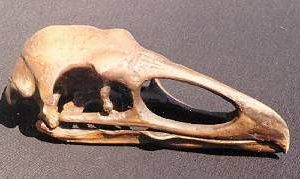T. merriami Bird Skull measures 9x4x4 inches. Teratornis Merriamai Bird Skull is museum quality polyurethane cast. Made in USA. 2-part skull (separate cranium and jaw)
The T. merriami was similar to condors, although an analysis of the functional morphology of its skull, namely its larger bill and ability to spread its mandibles and swallow its prey whole, suggests that it was an active and carnivorous predator rather than a scavenger.
Studies of skull morphology indicated that the Teratornis Merriamai were incapable of tearing pieces of flesh off of carcasses in the manner of condors.
Many old world vultures possess large bills, and a longer bill is a common feature among scavenging raptors, as this allow them to probe deeper into larger carcusses.
Other anatomical features, such as the relatively small and sideward facing orbits and the low skull, are also consistent with a scavenging lifestyle.
Teratornis had legs that were too short for it to take flight by running on flat ground. It is theorized that the Teratornis primarily inhabited cliff terrain, where it could take off and soar through the air easily.
Many T. merriami bone samples contributing to modern research have been found at the La Brea Tar Pits in Los Angeles, California.
Teratorns are thought to have been attracted by Pleistocene megafauna that became stuck and died in the viscous asphalt while trying to drink from pools of water that gathered on the surface, with the teratorns subsequently falling victim to the sticky deposits.
T. merriami probably played an important role in opening up the body cavities of carcasses for smaller birds like eagles and ravens which are also known to have frequented the locality.
For the T. merriami, small prey such as frogs, lizards, young birds, and small mammals were swallowed whole, while carrion would have been fed on in a manner similar to that of condors or vultures.

